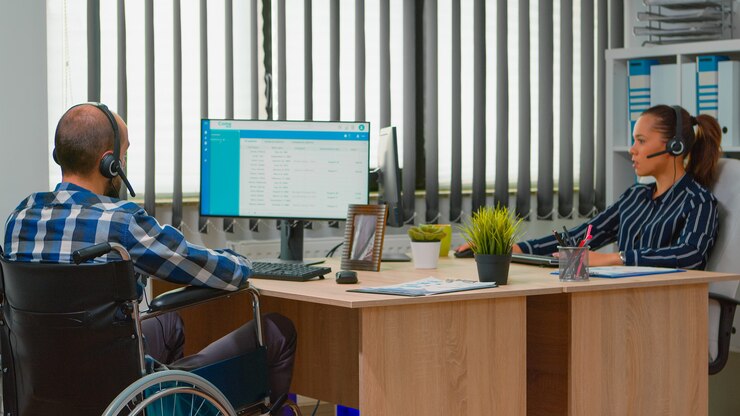How Accessible eLearning Development Supports Inclusive Learning
 vinay Bommena
vinay Bommena
In today’s digital era, eLearning has become a cornerstone of education, offering flexibility, scalability, and access to knowledge for learners around the world. However, as the adoption of online education grows, the need for inclusivity becomes increasingly important. Accessible eLearning development focuses on creating educational experiences that are usable and effective for all learners, regardless of their abilities or disabilities. By designing eLearning platforms and content with accessibility in mind, organizations can promote inclusive education and ensure that no learner is left behind.
This article explores the significance of accessible eLearning development and its impact on creating a more inclusive learning environment.

What Is Accessible eLearning Development?
Accessible eLearning development refers to the process of designing and developing online learning platforms, content, and resources that can be used by individuals with various abilities, including those with disabilities. This approach ensures that eLearning materials are accessible to all learners, including those with visual, auditory, cognitive, or physical impairments.
Accessible eLearning development typically includes the following key elements:
Content Accessibility: Ensuring that text, images, videos, and multimedia elements are accessible through alternative formats (e.g., captions, transcripts, or screen readers).
User Interface (UI) Accessibility: Designing user interfaces that are easy to navigate and interact with, including keyboard navigation and voice commands.
Compliance with Accessibility Standards: Adhering to international guidelines such as the Web Content Accessibility Guidelines (WCAG) to ensure accessibility for users with disabilities.
Why Accessible eLearning Development Matters
Accessible eLearning development plays a critical role in fostering inclusivity and ensuring equal access to education. Here’s why it matters:
1. Promoting Equal Access to Education
Education is a fundamental right, and accessible eLearning development helps ensure that everyone, regardless of their abilities, can participate in learning opportunities. For many learners with disabilities, traditional learning environments may present barriers. By making online learning platforms accessible, educational institutions and organizations can eliminate these barriers and provide equal opportunities for all.
Widening the Reach: Accessible eLearning opens the door for learners who may not have had access to traditional classroom settings due to physical limitations, geographic constraints, or other challenges.
Empowering Learners: Providing access to education in a format that suits individual needs empowers learners to pursue their academic and professional goals, ultimately contributing to a more inclusive society.
2. Meeting Legal and Ethical Responsibilities
Many countries have enacted laws and regulations that require educational institutions and organizations to ensure that their digital platforms and content are accessible to individuals with disabilities. For instance, the Americans with Disabilities Act (ADA) in the United States and the Equality Act in the UK mandate accessibility in education and online platforms.
Compliance with Accessibility Laws: Accessible eLearning development helps organizations comply with legal requirements and avoid potential legal consequences, such as lawsuits or penalties.
Ethical Responsibility: Beyond legal compliance, creating accessible eLearning content aligns with an organization’s ethical responsibility to provide fair and equitable education for all learners.
3. Enhancing the Learning Experience for All
While accessible eLearning development is essential for learners with disabilities, it also benefits the broader learning community. Accessible design principles, such as clear navigation, organized content, and alternative media formats, improve the overall user experience for all learners, regardless of ability.
Improved Usability: Features like keyboard navigation, intuitive interfaces, and alternative text formats make eLearning platforms easier to use for everyone, not just those with disabilities.
Inclusive Design: Accessible eLearning development encourages the use of universal design principles, which create more inclusive learning environments for diverse audiences, including learners with different learning preferences and styles.
4. Reaching a Broader Audience
Organizations that invest in accessible eLearning development can expand their reach and attract a broader audience of learners. By ensuring that content is accessible to individuals with disabilities, these organizations can tap into new markets, increase enrollment or participation rates, and enhance their reputation as inclusive educators.
Global Accessibility: Accessibility features like multiple language support, subtitles, and alternative content formats make eLearning courses accessible to non-native speakers, learners with limited internet access, and those using mobile devices in remote areas.
Increased Enrollment: Offering accessible eLearning solutions makes it possible for more individuals to enroll in courses, driving higher participation rates and supporting educational growth.

Key Features of Accessible eLearning Development
To develop truly accessible eLearning solutions, organizations should incorporate several key features and best practices:
1. Text Alternatives for Multimedia
Multimedia elements like videos, images, and infographics are commonly used in eLearning to enhance engagement and understanding. However, they can pose challenges for learners with visual or auditory impairments. Providing text alternatives, such as captions for videos, transcripts for audio content, and descriptive alt text for images, ensures that all learners can access the information.
2. Keyboard Navigation
Some learners, particularly those with physical disabilities, may not be able to use a mouse or touchpad to navigate an eLearning platform. Implementing keyboard navigation allows learners to interact with the platform using only the keyboard, making it more accessible for users with mobility impairments.
3. Screen Reader Compatibility
Screen readers are essential tools for learners with visual impairments. eLearning platforms and content should be designed to be compatible with screen readers, allowing users to have text and other content read aloud. Proper use of HTML tags and semantic structure ensures that screen readers can interpret and convey information effectively.
4. Clear and Consistent Layout
A well-organized and consistent layout is crucial for learners with cognitive disabilities or those who find complex interfaces overwhelming. Using simple, intuitive designs with consistent navigation, clear headings, and logical structure makes the eLearning platform easier to use for everyone.
5. Adjustable Text and Visual Settings
Allowing learners to customize their learning environment can significantly improve accessibility. Features such as adjustable font sizes, contrast settings, and color schemes help individuals with visual impairments or reading difficulties personalize the interface to meet their needs.
Implementing Accessible eLearning Development
Accessible eLearning development requires a strategic approach that includes collaboration between instructional designers, developers, and accessibility experts. Here are steps organizations can take to implement accessible eLearning solutions:
1. Conduct an Accessibility Audit
Before developing or updating eLearning content, organizations should conduct an accessibility audit to identify potential barriers for learners with disabilities. This audit can assess the usability of current platforms and content and provide insights into areas for improvement.
2. Adopt Accessibility Guidelines
Organizations should follow established accessibility guidelines, such as the Web Content Accessibility Guidelines (WCAG), which provide a framework for making web content more accessible. These guidelines cover areas such as perceivability, operability, understandability, and robustness.
3. Collaborate with Accessibility Experts
Working with accessibility experts can ensure that eLearning content and platforms meet the necessary standards and provide a positive experience for all learners. Accessibility experts can offer advice on best practices and help identify areas where content may need to be modified or enhanced.
4. Provide Ongoing Training
Accessibility is an ongoing process. Organizations should invest in training for their instructional designers, developers, and educators to ensure that they understand and implement accessibility principles consistently throughout the eLearning development process.

Conclusion
Accessible eLearning development is essential for creating inclusive educational environments that provide equal opportunities for all learners, regardless of their abilities. By prioritizing accessibility in the design and development of eLearning platforms, organizations not only comply with legal requirements but also enhance the learning experience for everyone. Investing in accessible eLearning solutions leads to better learner engagement, improved learning outcomes, and a broader, more diverse audience, making it a win-win for both learners and educators.
Subscribe to my newsletter
Read articles from vinay Bommena directly inside your inbox. Subscribe to the newsletter, and don't miss out.
Written by
